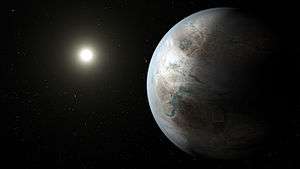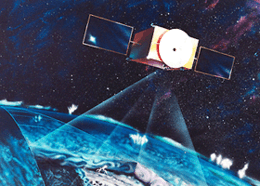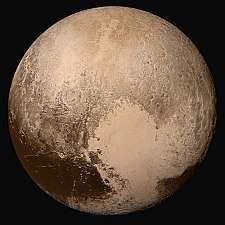List of Solar System objects most distant from the Sun in 2015

|
Sun Jupiter trojans (6,178) Scattered disc (>300) |
Giant planets: J · S · U · N Centaurs (44,000) Kuiper belt (>1,000) |

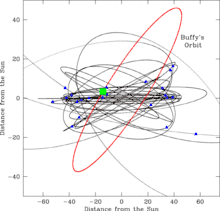
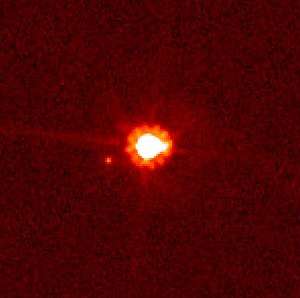
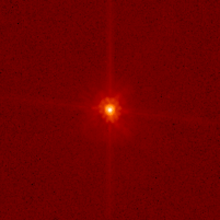
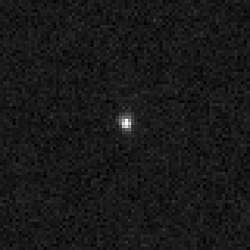
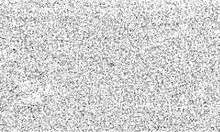

These Solar System objects were the furthest away from the Sun as of December 2015. The objects have been categorized by their approximate heliocentric distance from the Sun, not by the greatest calculated aphelion in their orbit.
This list does not mention objects that were discovered, but not announced, by 2015. An example would be 2015 TH367, which was discovered in October 2015 but not announced until 2018.
The list changes over time because the objects are moving. Some objects are inbound and some are outbound. It would be difficult to detect long-distance comets if it weren't for their comas, which become visible when heated by the Sun.
Distances are measured in astronomical units (AU, Sun–Earth distances). The distances are not the minimum (perihelion) or the maximum (aphelion) that may be achieved by these objects in the future.
List
| Body | Distance (AU) |
|---|---|
| V774104 | 103 |
| 136199 Eris | 96.3[1] |
| 2014 UZ224[A] | 91.9[1] |
| 2015 TH367 | 88.2 |
| (225088) 2007 OR10 | 87.4[1] |
| 2013 FS28 | 85.9[1] |
| (90377) Sedna | 85.8[1] |
| 2014 FC69 | 84.1[1] |
| 2006 QH181 | 83.34[1] |
| 2012 VP113 (aka "Biden") | 83.30[1] |
| "third sednoid" | 83[2] |
| 2015 UH87 | 82.3[1] |
| 2013 FY27 | 80.3[1] |
| 2015 TJ367 | 77.1[1] |
| 2010 GB174 | 70.6[1] |
| 2014 FJ72 | 70.1[1] |
| (148209) 2000 CR105 | 60.4[1] |
| 2003 QX113 | 59.9[1] |
| 2013 SY99 (aka "uo3L91")[B] | 59.8[1] |
| 2008 ST291 | 59.7[1] |
| 2013 JQ64 | 58.4[1] |
| 2004 XR190 (aka "Buffy") | 57.5[3] |
| 2006 HX122 | 55.5[3] |
| 2009 KL30 | 54.7[3] |
| 2013 GQ136 | 54.7[3] |
| 2004 VU130 | 53.8[3] |
| 2007 VK305 | 53.8[3] |
| 2002 FV6 | 53.8[3] |
| 2010 RF43 | 53.2[3] |
| 2010 RE64 | 53[3] |
| 2012 UT177 | 52.9[3] |
| 1999 KR18 | 52.65[3] |
| (136472) Makemake | 52.427[3] |
| 2009 KK30 | 52.382[3] |
| (42301) 2001 UR163 | 52.285[3] |
| 2013 JM65 | 52.209[3] |
| 2013 JV64 | 51.996[3] |
| 2007 LF38 | 51.931[3] |
| 2013 JH64 | 51.626[3] |
| (303775) 2005 QU182 | 51.323[3] |
| 2002 CY248 | 51.092[3] |
| 2000 CO105 | 51.083[3] |
| 2001 UP18 | 50.86[3] |
| 2001 OM109 | 50.849[3] |
| (386723) 2009 YE7 | 50.693[3] |
| (136108) Haumea | 50.676[3] |
| (437915) 2002 GD32 | 50.551[3] |
| 2011 UQ411 | 50.521[3] |
| 2000 AF255 | 50.157[3] |
| 1999 RU214 | 50.089[3] |
| (54520) 2000 PJ30 | 49.758[4] |
| 2011 UT411 | 49.68[4] |
| 2003 UB292 | 49.676[4] |
| 2004 DH64 | 49.494[4] |
| 2000 WM183 | 49.313[4] |
| (182397) 2001 QW297 | 49.305[4] |
| 1999 OG4 | 49.203[4] |
| (385362) 2002 PT170 | 49.173[4] |
| 2000 SK331 | 49.159[4] |
| 2011 UV412 | 48.961[4] |
| 2013 GT136 | 48.89[4] |
| 2013 FZ27 | 48.793[4] |
| 2001 KG76 | 48.467[4] |
| 2000 CK105 | 48.461[4] |
| 2000 CJ105 | 48.412[4] |
| 2013 GG138 | 48.38[4] |
| 2011 UM411 | 48.359[4] |
| 2011 UE412 | 48.312[4] |
| (202421) 2005 UQ513 | 48.286[4] |
| 1999 RX214 | 48.09[4] |
| 2003 FL127 | 48.087[4] |
| 2012 WD36 | 48.084[4] |
| 2003 HX56 | 48.069[4] |
| (90482) Orcus | 48.046[4] |
| 2005 EN302 | 47.967[4] |
| 2010 VK201 | 47.92[4] |
| 2014 FT71 | 47.872[4] |
| (385363) 2002 PW170 | 47.85[4] |
| 2002 CZ224 | 47.811[4] |
| 2006 JU58 | 47.803[4] |
| 1999 CP153 | 47.784[4] |
| 2001 KA77 | 47.755[4] |
| 2004 MU8 | 47.744[4] |
| 2002 CY154 | 47.73[4] |
| 2001 KL76 | 47.694[4] |
| 2005 EW318 | 47.657[4] |
| 2004 VN112 | 47.612[4] |
| 1998 WW31 | 47.578[4] |
| 2003 QA112 | 47.571[4] |
| 2013 FC28 | 47.404[4] |
| 2002 PA171 | 47.394[4] |
| 2013 SE99 | 47.387[4] |
| 2011 HE103 | 47.335[4] |
| 2002 XH91 | 47.318[4] |
| 2000 PL30 | 47.274[4] |
| 1999 OK4 | 47.254[4] |
| (19308) 1996 TO66 | 47.229[4] |
| 2004 HD79 | 47.193[4] |
| 2011 JX31 | 47.179[4] |
| 2002 VE130 | 47.131[4] |
| 2002 CX224 | 47.11[4] |
| 2004 KK19 | 47.066[4] |
| 2000 CG105 | 47.047[4] |
| (174567) Varda | 47.033[4] |
| 2004 PX117 | 47.007[4] |
| 2003 GF55 | 46.996[4] |
| 2000 CN105 | 46.982[4] |
| 2001 UN18 | 46.96[4] |
| 2004 VB131 | 46.953[4] |
| 2005 JA175 | 46.913[4] |
| 2004 OJ14 | 46.907[4] |
| 1999 CD158 | 46.858[4] |
| (307261) 2002 MS4 | 46.844[4] |
| 2011 UT412 | 46.831[4] |
| 2001 ES24 | 46.754[4] |
| 2000 CQ114 | 46.736[4] |
| 2000 PY29 | 46.719[4] |
| 2003 UZ291 | 46.687[4] |
| 2007 XV50 | 46.68[4] |
| 1999 CL119 | 46.656[4] |
| 2014 UF224 | 46.654[4] |
| 2009 KO30 | 46.644[4] |
| 1999 OA4 | 46.562[4] |
| 2000 FC8 | 46.554[4] |
| 2013 GV137 | 46.516[4] |
| 2002 PO149 | 46.486[4] |
| 2005 JR179 | 46.424[4] |
| 1999 CH119 | 46.419[4] |
| 2005 PT21 | 46.29[4] |
| 2013 JJ64 | 46.285[4] |
| 1998 KY61 | 46.219[4] |
| 2010 FX86 | 46.214[4] |
| (145480) 2005 TB190 | 46.201[4] |
| 2004 PW117 | 46.188[4] |
| 2000 YF2 | 46.154[4] |
| 2010 KZ39 | 46.148[4] |
| 2002 FX36 | 46.056[4] |
| 2011 US412 | 46.032[4] |
| 2009 DR143 | 46.005[4] |
| 2007 RM314 | 45.978[4] |
| 2013 RD98 | 45.962[4] |
| 2000 PG30 | 45.951[4] |
| 2000 WL183 | 45.942[4] |
| 2000 PM30 | 45.933[4] |
| 1999 RZ214 | 45.929[4] |
| 2005 EB318 | 45.924[4] |
| 2000 PD30 | 45.918[4] |
| (66452) 1999 OF4 | 45.902[4] |
| 2003 QB91 | 45.897[4] |
| 2001 OQ108 | 45.864[4] |
| (1999) DA | 45.844[4] |
| 2012 UH177 | 45.842[4] |
| 2003 TK58 | 45.834[4] |
| (148780) Altjira | 45.814[4] |
| 2013 GK137 | 45.771[4] |
| 2004 LW31 | 45.753[4] |
| (55565) 2002 AW197 | 45.753[4] |
| 2013 GE138 | 45.714[4] |
| (363330) 2002 PQ145 | 45.671[4] |
| (385201) 1999 RN215 | 45.65[4] |
| 2005 EE296 | 45.645[4] |
| (79978) 1999 CC158 | 45.632[4] |
| 2013 JG64 | 45.595[4] |
| 2011 UF412 | 45.584[4] |
| 2000 CP104 | 45.536[4] |
| 2001 HA59 | 45.442[4] |
| 1995 WY2 | 45.437[4] |
| 2000 QE226 | 45.435[4] |
| 2011 UZ411 | 45.366[4] |
| (78799) 2002 XW93 | 45.351[4] |
| 1996 RR20 | 45.35[4] |
| 2000 CQ105 | 45.336[4] |
| 2003 UT291 | 45.331[4] |
| 1999 OM4 | 45.29[4] |
| (69988) 1998 WA31 | 45.29[4] |
| (82075) 2000 YW134 | 45.277[4] |
| 2003 KO20 | 45.264[4] |
| 2005 JY185 | 45.264[4] |
| 2000 WV12 | 45.249[4] |
| 1999 GS46 | 45.232[4] |
| (15883) 1997 CR29 | 45.203[4] |
| 2000 FB8 | 45.156[4] |
| 2000 YA2 | 45.15[4] |
| (88611) Teharonhiawako | 45.142[4] |
| 2005 CD81 | 45.131[4] |
| 2000 PA30 | 45.123[4] |
| 2011 UB412 | 45.095[4] |
| (84522) 2002 TC302 | 45.071[4] |
| 2007 CQ79 | 45.043[4] |
| 1998 WX24 | 45.038 |
| 2000 WT169 | 45.024[4] |
| (48639) 1995 TL8 | 45.02[4] |
| 2013 FA28 | 45.015[4] |
Notable objects
The discovery of an object known as V774104 was announced in November 2015 and was heralded by many news outlets as "the most distant Solar System object", surpassing Eris by close to 7 AU (not counting space probes and long-period comets). There is some confusion regarding its distance as of 2018, as V774104 might now be suspected of being closer than Eris,[5] but this is due to a misunderstanding (which arose because Scott Sheppard was referring to an unannounced Sednoid).[6]
Another very distant body is Sedna, which was discovered in November 2003. Although it takes over 10,000 years to orbit, during the next 60 years it will slowly move closer to the Sun as it comes to perihelion.[7]
See Also
- List of Solar System objects most distant from the Sun in 2018
- List of Solar System objects by greatest aphelion
- List of hyperbolic comets
- Pluto (30–49 AU, about 34 AU in 2015)
- List of trans-Neptunian objects
- Objects with very large aphelion
References
- 1 2 3 4 5 6 7 8 9 10 11 12 13 14 15 16 17 18 AstDyS-2 list of minor planets more than 57 AU from the Sun → Archived 21 September 2015 at Archive.is
- ↑ Astronomer Michele Bannister (29 Mar 2018)
- 1 2 3 4 5 6 7 8 9 10 11 12 13 14 15 16 17 18 19 20 21 22 23 24 25 26 27 28 29 AstDyS-2 Distance down to 50 AU
- 1 2 3 4 5 6 7 8 9 10 11 12 13 14 15 16 17 18 19 20 21 22 23 24 25 26 27 28 29 30 31 32 33 34 35 36 37 38 39 40 41 42 43 44 45 46 47 48 49 50 51 52 53 54 55 56 57 58 59 60 61 62 63 64 65 66 67 68 69 70 71 72 73 74 75 76 77 78 79 80 81 82 83 84 85 86 87 88 89 90 91 92 93 94 95 96 97 98 99 100 101 102 103 104 105 106 107 108 109 110 111 112 113 114 115 116 117 118 119 120 121 122 123 124 125 126 127 128 129 130 131 132 133 134 135 136 137 138 139 140 141 142 Hundreds of minor planets between 45–50AU
- ↑ Beatty, Kelly (29 January 2018). "V774104 update". Retrieved 14 March 2018.
- ↑ Astronomer Michele Bannister (29 Mar 2018)
- ↑ Most Distant Object In Solar System Discovered
